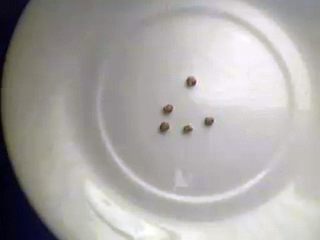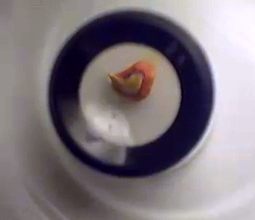September 27, 2005
Cactus
 My newest horticultural experiment is with cactus seeds. This past weekend I was in Colorado for a friend's wedding. I had arrived early for the rehearsal so I was standing around the parking lot when I noticed a bright red fruit that had recently fallen off a small cactus plant.
My newest horticultural experiment is with cactus seeds. This past weekend I was in Colorado for a friend's wedding. I had arrived early for the rehearsal so I was standing around the parking lot when I noticed a bright red fruit that had recently fallen off a small cactus plant.
I found an empty Pringles can in the car (bad junk-food admission here!) so I popped the object into the can and later packed it into my bags and brought it back home to Los Angeles. Actually, I was a bit worried that I might be breaking some unknown law by transporting a plant on the airplane. I imagined that someone in security would think it was a peyote button or some such thing and detain me. Alas I made it through fine and brought the fruit (for a cactus, is the fruit called a "pear"?) home.
For the next two days I was too busy to look at my treasure, so it just sat inside a plastic bag, wrapped in a tissue. This morning when I retrieved it I discovered that the fruit had ripened dramatically. There was a powerfully sweet smell similar to strawberries. The fruit was very soft and when I squeezed it a mass that resembled preserves oozed out the end. This mass had many seeds that were coated in a slimy substance. It reminded me a lot of the inside of an extremely ripe pomegranate, actually.
I washed the mass of seeds and dried them on a paper towel, attempting to remove as much of the slimy coating as possible. In the end I had 90 mature-looking seeds and 10 lesser-developed seeds.
Now comes the question of how I'm going to try to germinate these seeds. Seed germination is a really tricky endeavor because seeds are designed to stay dormant for a certain amount of time and then become active under very specific stimuli. Some seeds stay dormant until they have been subjected to cold conditions for an extended period of time (a few weeks) to insure they sprout in the Spring. Other seeds are inhibited by some chemicals present in the fruit so they will germinate when they've been removed from the fruit (by some animal usually). Some seeds have very strong outer casings that must first be "damaged" whether by physical wear or by the digestive system of a bird or rodent before water can get through to start germination...
 So I've got 90 seeds and need to come up with some means for experimenting quickly but effectively to find the best germination mechanism for this species. My gut feeling is that the growth-inhibiting mechanism was the slimy coating inside the seed case. Hence I'm hoping that one I've cleaned this coating off that the seeds with germinate readily. I also have a hunch this is the case because if you look at one of the seeds closely (see the photograph of a seed under a photographer's loop) you'll notice that the inner part of the seed appears to have a little tail that extends to the outside of the seed case. This doesn't look like a sort of super-armor casing that is going to require chemical or physical damage to get moisture to the embryo. But then again, I could be wrong.
So I've got 90 seeds and need to come up with some means for experimenting quickly but effectively to find the best germination mechanism for this species. My gut feeling is that the growth-inhibiting mechanism was the slimy coating inside the seed case. Hence I'm hoping that one I've cleaned this coating off that the seeds with germinate readily. I also have a hunch this is the case because if you look at one of the seeds closely (see the photograph of a seed under a photographer's loop) you'll notice that the inner part of the seed appears to have a little tail that extends to the outside of the seed case. This doesn't look like a sort of super-armor casing that is going to require chemical or physical damage to get moisture to the embryo. But then again, I could be wrong.
Another known variable is the length of viability (aka shelf life) of these seeds. I've read that there is a huge amount of variety in seed storage length, from a couple of weeks to 20-30 years under the best cryogenic conditions! If I create an experiment to determine the optimum germination strategy and don't factor in shelf-life, I could end up with greatly skewed results. Also there's the question of what proportion of the seeds are viable. Maybe only 1 in 4 seeds is capable of germinating, in which case if I try varying conditions in batches of 2-3 seeds I may have entire batches that don't germinate despite being in the best possible growing condition!
Here are my thoughts: I think I should store most of these seeds in the refrigerator. Since the plant was found in the foothills of Colorado, it obviously can survive winter conditions. I'm guessing that the refrigerator will not harm the seeds, and if anything it should probably extend their shelf-life and might trigger a temperature mechanism that might be required for germination!
Since I have 90 seeds, I think my "batch size" for trying different germination techniques will be 6 at a time. That will allow for 15 different germination conditions which I'll have to plan out soon.
My germination strategy will be this: I have a squat cylindrical plastic case that looks something like a huge petri dish. I will place a seed on a small piece of rock-wool (so it's not sitting in water which could induce rot) and I will apply some moisture to the container with a spray bottle. Then I'll cover the container with plastic wrap. This way I can tell instantly if the seed is germinating. If or when it does, I will plant the sprout when it is about a centimeter in length.
Here goes nothing!
Posted by Murray Todd Williams at September 27, 2005 09:51 PM